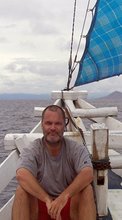
On Words
The threat of the goggle-box
By ANDREW GREENE
I sat up straight. Surely, I thought, as a small-screen enthusiast, this development was to be to my delight.
“Finally,” I inwardly rejoiced, “the cycle was complete. At last, the time had arrived in which we have television programming to pull us wet and swaddled from the womb, propel us all through life, before finally surrendering our wide-eyed, empty-headed bodies back into mother earth’s embrace.”
Cradle to grave goggle-box. How could this possibly be wrong?
But, then I remembered hearing about a study published by the
Suddenly my comfort food left me cold and with bits of powdery orange-pasta drying in the corners of my mouth, I lowered the bowl.
As a parent of a soon to be ten year old, I am utterly aware of all, ok, some, of the influences children face nowadays. In our enlightened era in which Mc Donald’s is introducing healthy kid’s meals and smoking has been outlawed on the thoroughfares of Jakarta, do we really need to take a step back and introduce our children to an addiction at yet an even earlier age?
How far behind can the Cemal or Pell Mell (their misspellings, not mine) candy cigarettes of my boyhood be? Next thing you know there will be children’s Visa debit cards and Bintang Zero alcohol beer. All props for a twisted make-believe world, these are best relegated to Tim Burton’s silvery screen and out of our more-than-Technicolor lives. The buying on credit, binge drinking, and eating disorders can surely be put off until the university years.
Watching television dulls your awareness so that you do not notice messages to your brain saying that you are full. This is why it is so easy for you to mine through an entire bag of chips or a pint of Hagen Das while you are distracted by the latest madcap happenings of your favorite fictional family.
Two 2005 studies published in The Journal of Pediatrics said that children who watched too much telly were prone to fatness. R.M. Viner and T.J. Cole from the University College London found that every hour over the recommended 1.5 hours of daily television watched by five year olds raises the risk of them becoming obese by the age of 30 by seven percent.
In the other study, on the Atlantic’s modern side, Doctors Kirsten Davison, Lori Francis, and Leann Birch from the State University of New York discovered that nine and 11 year old girls who exceeded recommended guidelines of television viewing were 2.6 times more likely to be overweight than girls who watched less television.
Television in and of itself does not make us stupid. The danger is that it is such a demanding, time-devouring habit that it keeps us away from true life experiences.
In 1991, other tests of young teens from more than a dozen countries showed that in math and science “Students who watched the most television had the lowest scores.”
A 2005 edition of The Archives of Pediatric and Adolescent Medicine quoted Doctor Dina Borzekowski as saying about similar tests, “Among these third graders, we saw that … those who had bedroom TV sets scored around eight points lower on math and language arts tests and seven points lower on reading tests.”
Though the above studies were conducted in the West, Indonesian children are not safe. They too are falling victim to the same electronic demon, watching well-above the recommended limit of 1.5 daily hours. The Children Media Development Foundation (Kidia) says, “The average Indonesian child watches between 30 and 35 hours of television per week, or 1,560 to 1,820 hours per year.”
Kidia’s Chairman, Boby Guntarto, told The Jakarta Post just over a year ago during the nation’s first “No Television Day,” “Children who watch too much television are more likely to be overweight and unhappy. It also affects brain development and learning."
It is clear that this seemingly-innocuous practice can hook and detrimentally affect us no matter where we live. Next week’s On Words column will explore some techniques that can help you and your family kick the television habit.
This article was originally published in The




